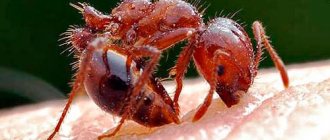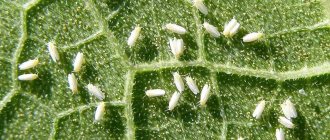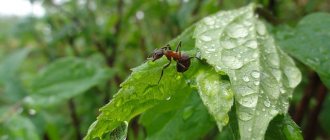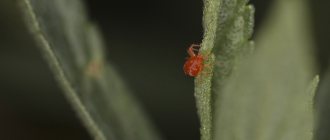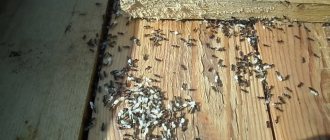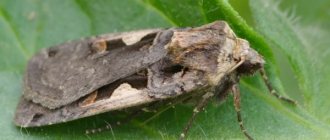The benefits and harms of ants in a greenhouse
Black garden ants constantly loosen the soil and thereby saturate it with oxygen, which has a beneficial effect on plant growth. They dispose of insect carcasses, process them, and help replenish the soil with phosphorus and potassium in forms that are beneficial to plants. They kill other insect pests. This is where the benefits of ants for the greenhouse end.
But the harm from them is much more noticeable:
- eat leaves, buds, fruits;
- damage the root system, shoots, trunks;
- bring weed seeds;
- eat seeds and seedlings;
- aphids are bred, which destroy greenery;
- acidify the soil;
- they bite people working in a greenhouse with plants and the ant’s bite is quite painful;
- They carry pathogens of infectious diseases - both human and those affecting cultivated plants.
Ants must be removed from the greenhouse. It’s one thing if several ants crawled into the greenhouse, but it’s completely different when there are a lot of insects or, even worse, they built their own anthill in the greenhouse.
Where did they even come from?
If ants appear in a greenhouse, there may be three reasons:
- The insects went their own way and turned into the greenhouse to investigate. The important thing here is to simply kick them out in time.
- A new nest has appeared on your site, and pests go to the greenhouse to grow aphids there - it’s more convenient. Just get rid of the aphids and scatter the cut garlic cloves over the beds.
- The nest appeared right inside the greenhouse, by digging from outside. It’s not so easy to find - you won’t see any anthill, it’s just a small hole, under which, however, a whole kingdom is already being built. Search and destroy.
First of all, figure out what kind of enemy wandered into your greenhouse. So, in Russia the following types of ants are most often found:
- Black garden ones.
- Red forest ones.
- Brown meadows.
If your site is located near a forest, expect red insects to visit you, but they usually avoid the greenhouse. But closed, warm soil is more attractive to black garden ants, which brazenly build their nests right in the beds. And with our multiple passages underground, we disrupt the root system of everything that grows in the greenhouse, which is why we may not get a harvest. At the same time, black ants feed on plant seeds and seedlings.
But if you meet one of these comrades, proceed very carefully:
Anthill in a greenhouse: how to get rid of it
Black garden ants usually infest the greenhouse. They are quite large and differ from their forest relatives not only in color, but also in their housing. Unlike forest redheads, they do not build a ground hill, but arrange a den underground. It can be of the same impressive size, with a large number of internal passages. Only a small hole is visible from the outside. So that the ants do not have time to build their lair in the greenhouse. the soil in it must be periodically dug up and loosened regularly.
If you find such a nest, you need to destroy it. If it is located near plants, you can try to carefully dig it out, being careful not to touch the roots. The soil with ants and their eggs should be put in a bag and taken away, preferably spilled with boiling water, or thrown into the fire to burn the pests.
If a nest is discovered after harvesting, it needs to be covered with quicklime, filled with water, and after a couple of days the ground must be dug up. You can repeat the procedure. You can simply pour boiling water over the area, wait a little and dig up the soil. To get rid of an anthill, you can mix vegetable oil and boiling water in equal proportions, add vinegar or essential oils. You can use sunflower oil left over after cooking. This solution is poured into the nest.
Another way is to dissolve two tablespoons of baking soda in two liters of boiling water and pour the mixture into the anthill. You can mix soda and sugar in equal proportions and fill the nest with the dry mixture.
It is not recommended to do this with plants growing in a greenhouse, because you can burn the roots of the plants.
Traditional methods for getting rid of ants in a greenhouse
Ants do not like strong odors, including the smell of tomato tops. When cutting off the lower shoots of tomatoes, you don’t have to throw them away, but spread them on the ground - this will scare away the ants.
You can use other “fragrant” methods to fight ants:
- wrap plant shoots or place garlic shoots in beds;
- plant fragrant herbs and flowers: marigolds, oregano, mint, lavender, parsley, fennel, rosemary, etc.;
- Place rags and rags soaked in kerosene in the aisle between the beds (not on the ground with the plants!). You can also coat the inside of the greenhouse with a kerosene solution (4 tablespoons per 10 liters of water) on the wooden structures, glass or polycarbonate from which it is made. The main thing is not to pour kerosene into the soil and not to work immediately after processing in a greenhouse with the door closed;
- prepare a weak solution of ammonia (5 ml of ammonia per 5 liters of water) and spray all the plants with it, water it at the root, spill the soil in places where ants accumulate, you can pour it into the nest and cover it with a cloth to enhance the effect;
- ammonia is safe for cultivated plants, but it is important not to exceed the concentration so as not to burn tender shoots and leaves;
- dissolve 120 grams of dry mustard in 2 liters of water, leave for three days and spray the plants generously; you can also sprinkle dry mustard on ant paths;
- Under the plants, you can sprinkle ash, baking soda, cinnamon, coffee grounds, or ground pepper on the soil. Just don’t forget about this treatment, otherwise it will be very unpleasant to work in the greenhouse; these substances themselves are safe for plants, and the ash is also useful.
All of the above methods are aimed more at scaring away ants. If there is no nest in the greenhouse, then they can help get rid of ants that crawl in from the outside. But if there are too many insects in the greenhouse, then pest control should be more active and preferably using chemicals.
Methods for controlling ants in a greenhouse
The reasons for the appearance of ants on closed soils are very banal: they are attracted by the smell of organic matter and the temperature and humidity characteristics of the greenhouse. A greenhouse for ants is an ideal place to live, in which they have sources of water, food and all the opportunities to increase the population. Most often, black “garden” and red “forest” ants appear in greenhouses. Despite their different habitats, both the former and the latter feed on roots, seeds, young shoots, and sweet fruits of vegetable crops. How to get rid of ants in a greenhouse if it is impossible to eliminate the natural cause of their appearance?
Gardeners practice a lot of effective ways to combat these insects, among which the following should be highlighted:
- Use of folk remedies.
- The use of insecticides and various chemicals.
They all have their advantages and disadvantages. To figure out how to quickly and safely get rid of ants in a greenhouse, let’s look at each method in more detail.
How to kill ants in a greenhouse
There are folk remedies that do not repel, but kill ants. First of all, it is boric acid. It paralyzes the nervous system of ants, which leads to death. All sorts of baits are made based on boric acid. The simplest of them is to mix two tablespoons of jam with five tablespoons of water and add a third of a teaspoon of boric acid. Place the resulting mass in flat containers in a greenhouse or greenhouse.
You can also use dry boric acid, which must be mixed with a few tablespoons of thick honey. You can add boric acid to a mashed boiled egg, minced meat or brewer's yeast, roll the resulting mixture into balls and place them in different parts of the greenhouse.
The principle of operation of such baits is very simple: ants bite off pieces of foods that are attractive to them, carry them on their paws to the anthill, treat them to the queen and die after some time.
It is important that the concentration of boric acid in the treat is not too high. The fact is that you need to kill not only the worker ants, but also their queen. She does not get food herself, does not leave the anthill, but worker ants bring her food.
Folk remedies
When ants appear in a greenhouse in small numbers, folk remedies and “old-fashioned” methods of dealing with them help.
Places where insects accumulate are filled with homemade compounds:
- with the onset of cold weather, remove the top layer and provide water under pressure;
- in the summer, pour molasses and water with jam - soil yeast will destroy ant reserves for the winter.
When unexpected guests appear before the seedlings are planted, they use this method: they dig up a place where insects accumulate, pour boiling water on them, and open the doors. In this case, the ant eggs die and the danger of pests multiplying is prevented. They use sunflower oil left over from frying food: pour it into the minks.
Insects mistake millet or semolina sprinkled on an anthill for eggs and drag it into their home. All that remains is to fill everything with water and wait for the swollen grain to close all the entrances and force them to retreat.
Garlic placed indoors and traps with sweet baits: jam, sugar, honey help. As they become filled with insects, fill them with water or take them outside the room.
Important! The gastrointestinal tract of ants is not able to digest starch. Peeling potatoes will rid you of pests.
Plants are used to repel ants:
- infusion of wormwood and delphinium;
- tomato and anise leaves;
- garlic infusion.
Balls of minced meat and boric acid in a ratio of 100:5 are spread throughout the entire territory, after 14-15 days the population will decrease or disappear altogether. Pieces of salted herring or herring are also not to the taste of ants.
Several folk methods deserve attention:
- Strips of natural sheepskin are cut, lubricated with crude carbolic acid and the plants are tied at a distance of 15-18 cm from the ground.
- The soil around the anthill is doused with carbon sulphide and set on fire. This method is used only before planting seedlings.
- Fill with kerosene;
- Sprinkle with a mixture of ash, lime and crushed tree bark.
- Cover with a mixture of oregano and sulfur in a 1:2 ratio.
Getting rid of it forever is possible only with the comprehensive use of all methods and medications.
Use of insecticides
Before planting plants in a greenhouse, it is usually treated for pests. You can also use many products to treat greenhouses and greenhouses with plants already planted in them, but before the active formation of ovaries and fruiting. Typically, recommendations indicate that anti-ant treatment should be carried out no later than 20 days before harvest.
What products should I use to get rid of ants?
When digging up the soil, it is convenient to use granules, and the walls of the greenhouse and paths between the beds can be washed, sprayed, or shed generously with liquid products. For example, you can use Medilis-Super, Medilis-Ziper, Medilis-Neo. They are diluted in water in accordance with the instructions; they can be used to wipe surfaces or spray. Products in the form of gels, for example, Medilis-Antimant or Medilis-Anti-Cockroach, are not very convenient to use in a greenhouse. It is better to squeeze the gel onto a flat surface, and there is not too much free space in the greenhouse or greenhouse. But you can use them too.
Ant: description and life cycle of the pest
Ants are insects that live in large groups, organizing huge anthills. In one anthill there is usually only one queen, who carries out the process of laying eggs.
All other ants are busy collecting “building material” for their anthill, as well as food. It is in the second question that these insects pose a particular danger to gardeners, since they love to feed on juicy and sweet berries, vegetables and root vegetables.
New generations of ants appear very quickly - almost every 2 months. To do this, the queen first lays eggs, which are kept in the passages of the anthill for 35 days, after which larvae emerge from them.
Their life cycle is also short, only 7 days, after which the larvae are wrapped in their own secretions and turn into pupae. Only at the fourth stage do small ants emerge from the pupae, grow rapidly and immediately begin to fulfill certain obligations.
Did you know? Ants are able to mark the path they have taken with the help of special smells, thanks to which they always unmistakably return to the anthill and, if necessary, can again find the place where they saw a lot of “prey”.
To block the path of pests, it is important to diffuse the pungent smell of garlic, mustard, and mint in the greenhouse. It is worth noting that there are many varieties of ants, but often only the following are found in gardens and greenhouses:
- red forest ones (most often found in dachas that are located near forested areas);
- black garden ones, which can most often be found in greenhouses and which severely damage young plant seedlings;
- brown meadow (the least common in greenhouses).
What benefits do ants bring? Despite the fact that the title of our article is devoted to the question of how to get rid of ants in a greenhouse, we should not ignore the benefits of these small insects. After all, if they appeared in your greenhouse, then this will allow:
Get rid of a number of pests of garden plants, such as caterpillars, fly larvae, slugs and spider mites, as these pests are food for ants. Improve soil fertility, as numerous ant passages will make its structure as loose and filled with air as possible.
Unlike earthworms, ants are able to go deeper into the soil not by 20 cm, but by the entire 1.5 m. Improve the nutritional value of the soil, since the content of potassium substances in it when ants appear increases by 2 times, and phosphorus by about 10 times .
Also, during the life of ants, humus and nitrogen appear in the soil. It is very important that all these substances, under the influence of ants, transform into a soluble form necessary for plant nutrition.
Important! The rapid reproduction of ants in a greenhouse is due to the fact that even at sub-zero temperatures outside, a favorable temperature and a sufficient amount of moisture will always remain under the film.
Therefore, after the autumn harvest, it is important to open the greenhouse and allow the first frosts to freeze the top layer of soil in which ant eggs can be stored.
Prevention
To avoid the appearance of ants in large numbers in the greenhouse, it is necessary to regularly loosen the ground, destroying the passages, paths, and paths familiar to these insects. When digging and loosening, you can destroy their lair and destroy the queen. When digging seasonally, you need to add ash, charcoal or insecticides in the form of granules to the soil.
Before planting seedlings in a greenhouse, some gardeners carry out pre-planting soil treatment:
- pour boiling water over it with the addition of hot pepper;
- prepare a mixture of one liter of water, 5 grams of soda and 30 ml of flaxseed oil (can be replaced with another vegetable oil) and water the ground with this solution;
- simply pour a large amount of boiling water over the beds.
When using all means to combat ants in a greenhouse or greenhouse, it is important to read the instructions and compare the harm that even folk remedies can cause with the troubles that ants cause. Sometimes the remedies are too aggressive. In addition, if ants do not live in the greenhouse all the time, but crawl in there from time to time, there is no need to fight them. This can disrupt the natural eco-system, which is important for the normal ripening of the crop.
How dangerous are ants for a greenhouse?
Ants are useful in a greenhouse only if their colonies are not yet numerous. However, if ants in a greenhouse multiply incredibly quickly, the question of how to get rid of them becomes urgent. How can these insects be dangerous?
Ants are capable of secreting a kind of acid, which can cause the acidity of the soil to rapidly increase. As you know, not all garden plants like such soils, which have to be limed to get a good harvest.
The main diet of ants is not only the larvae of various pests, but also young shoots of garden plants, as well as their sweet fruits. Therefore, if the ant family multiplies significantly, the greenhouse may be seriously damaged and not produce a harvest.
Adult ants are very fond of sugar, which is important for their normal functioning, so they can independently reproduce entire colonies of aphids. This pest can, in turn, multiply and feed on garden plants, thereby causing irreparable damage to the crop, and sometimes complete death of the plants.
Ants can organize their anthills directly among the rows of greenhouse plants, thereby preventing them from growing normally. Since the ants’ habitat is not limited to the greenhouse, they can bring weed seeds into it from the garden plot, which, under favorable conditions, quickly germinate and choke out garden plants.
But, in addition to harm to the greenhouse itself and the plants growing in it, ants can also pose a danger to humans. Indeed, with the massive spread of ants, it will be very difficult to avoid their bites, during which the insects secrete a specific acidic secretion.
In addition to the fact that such a bite is quite painful, it can cause an allergic reaction in some people.
Important! Ants do not do well where there is a lot of moisture. Therefore, if the greenhouse maintains high humidity and the plants are watered frequently, ant activity can be stopped.
How to remove ants from a greenhouse: control methods
If ants are found in the greenhouse, you need to get rid of them as soon as possible. To remove them, you need to disinfect the soil.
If possible, it is better to remove the ants without killing them. But many gardeners are determined to get rid of insects once and for all.
There are four methods of pest control - physical, chemical, combined and the use of industrial chemicals.
The physical method consists of finding an ant house and relocating all its inhabitants as far as possible from the greenhouse or garden. This method will work if the ants are living in the rotting wood of the greenhouse frame.
To reduce the likelihood of ant colonies appearing, every spring you need to treat the soil with a solution - 1 liter of settled water + 1 teaspoon of soda + 1 tablespoon of linseed oil. Also, when digging up the beds after harvesting, the discovered anthills can be sprinkled with regular baking soda or quicklime.
Ants cannot stand the strong smell of garlic, so gardeners who do not have the opportunity to use boric acid fill anthills with water containing garlic infused in it. Ants also do not like the smell of mint, elderberry, and wormwood.
Combined methods of getting rid of ants involve the use of sweet bait. You need to put a piece of cloth in an old deep pan and pour a little water on it. Sprinkle the bottom with sugar or sprinkle with jam/honey and place the trap in the greenhouse. The queen will crawl into the container and bring the offspring with her. After this, the fabric with the ant family must be collected and taken as far as possible from the greenhouse and open beds. Or you can destroy a family by pouring boiling water on them.
Dry mustard is used to prepare a solution for watering and spraying plants in a greenhouse. Dissolve 2 tablespoons of dry mustard in a liter of hot boiled water, close the lid and let it brew for 36 hours. Mix the resulting mixture with 3 liters of water, spray it on plants affected by ants or water the ant passages.

